SUP Interviews »Yvonne from SUP Dog
Interview with Yvonne from SUP dog
In this interview, Yvonne explains how SUP works with dogs .
This interview is a great addition to the one with Jenny, who is especially responsive to the dogs .
Hello Yvonne. Please imagine my reader first.
I’m a dog physiotherapist, I’m from Nuremberg, and I have 2 animal physiospraxes with my colleague.Time permitting, I’m on the water and sometimes traveling.
How did you actually get on stand up paddling with dogs?
I grew up with surfing and about 5 years ago – just when Stand Up Paddling came up – I bought an inflatable SUP board.
My colleague, a graduate biologist, lived in Hawaii for a while and was immediately excited to use the board in our physio practice for stability training and muscle building in the pool (as an alternative to the wobbly board).
From USA and Australia we already knew the “Surfdogs” and we started to bring our own dogs to Stand Up Paddling.
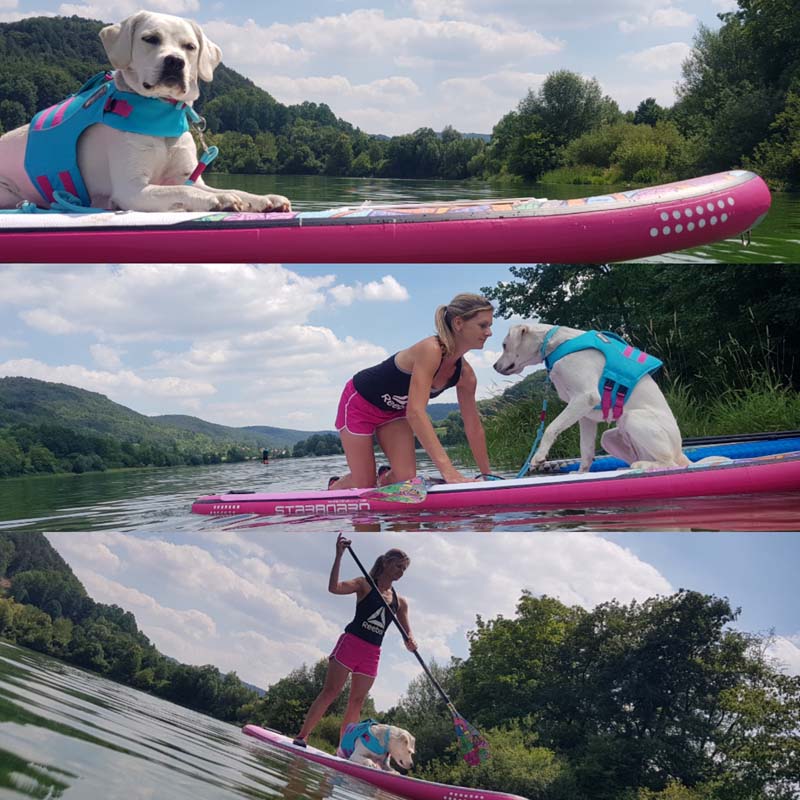
They loved it and were mentally and physically busy after a trip.
Even my today 16-year-old Hundeomi was there at some point and wanted to join. She was previously active in dog sport (agility) and SUP is the perfect joint-gentle sport for her.
What are the requirements for common stand up paddling with dogs for paddlers and dogs?
No, not really.
Every human-dog team has different requirements:
- size
- mass
- Older
- Wasserjunkie, careful “Kneipphund” (ie up to the water, duck hunter, junior, senior, athlete, Couchpotatoe, knee and hip disease …).
Then you should tune Tempo & equipment.
The basis is that you practice even the stand up paddling including paddling technique with twists and stops and take the dog only when you’re safe yourself.
It takes confidence and certainty to venture out of water together, but then it strengthens the bond with the four-legged friend.
You can practice the SUP dog sport at any age and if the dog is still unsure, you do not have to paddle while standing and can simply paddle longer kneeling.
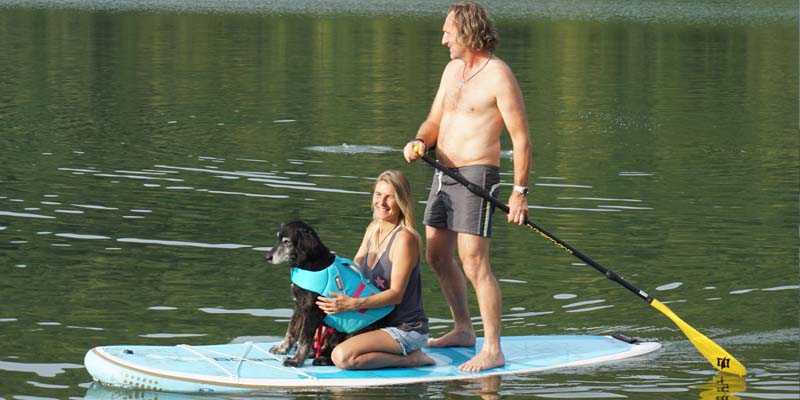
If I also decide to go paddling with my dog, can I take my normal SUP board or do I have to pay attention?
Basically:
The larger the dog, the more important the width of the board.
This is important so that the dog can turn well and take a comfortable position without slipping off the board. In addition, the board must be designed for the total weight (man + dog). In addition, full-surface cover pads reduce the risk of slipping.
My tip: Put a big box on the floor, measure the ruler and measure the turning circle of the dog. Then you have an orientation for the board width.
For beginners, a tilt-stable board is recommended. The more advanced and safer the dog, the better he gets with a rickety and sportier board.
Do not worry, the new inflatable iSUPs will last a lot! Normal dog claws are no problem with a branded board as the rubber is very sturdy.
Top dog life vests – do you need one or can you do without it?
Many think spontaneously “my dog can swim” !.
Right, but it can always come to an emergency situation and the vest protects the dog and can become a life-saving accessory.
The life jacket works similar to its counterparts for humans. It is important that the buoyancy cells (the parts of the vest where much buoyant material is used) are positioned so that the dog does not get in a lurch and its natural swimming movements are not affected.
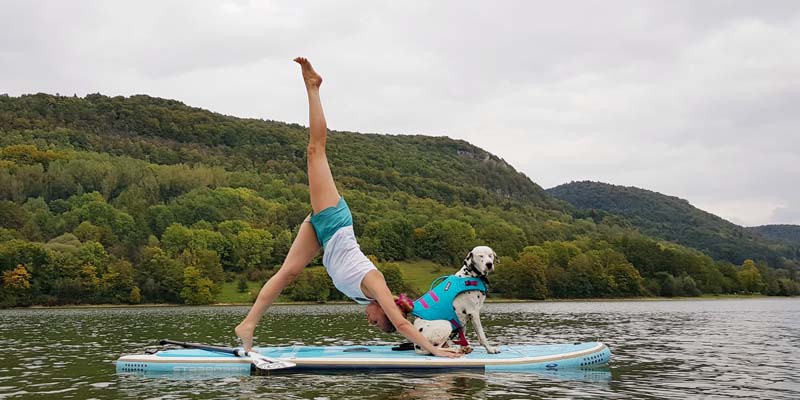
Thanks to the buoyancy, a life jacket also protects the dog’s powers, making it easier to reach the rescue shore or to be salvaged by the owner.
Especially with water sports with a dog, the handle on the top of the vest is an important tool to guide the dog safely on board as well as on board.
Most models are equipped with signal colors and reflectors, making the dog recognizable to other water sports enthusiasts.
Model, size and shape depend on the stature of the dog.
The neck, abdominal girth and back length are measured – the latter is especially important as the life jacket must not be too long.
The dog needs the rear part of the body (linden spine and tail approach) to control.
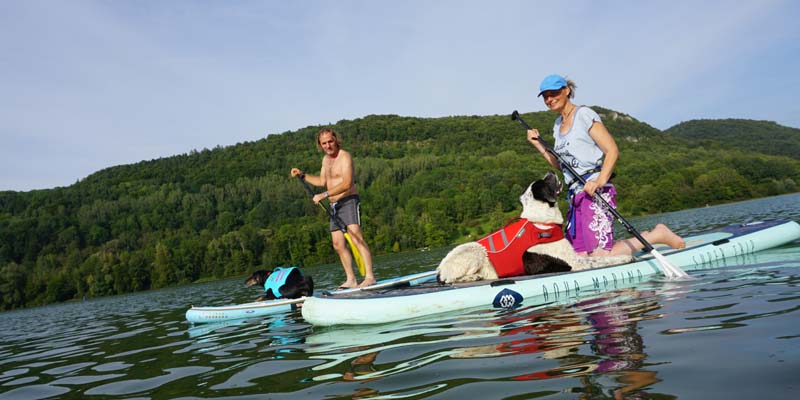
Important: The dog should not be limited in its freedom of movement when carrying.
The difference between Schimm. and lifejackets is that swimming aids only support, on the other hand, lifejackets also secure the disabled dog from going under.
You have a course in which people can learn how to run Stand Up Paddling together with their dog. What is offered to you concretely?
In our courses, we individually address the different human-dog requirements.
Through our almost 5 years of course experience, we can give many tips. For example, how it works for the respective team the best.
It is practiced in small groups (about 3 to 5 teams). The training concept is the result of many years of experience in animal physiotherapy, dog sports, animal training and our personal passion for water sports.
It is especially important to us that we discover the new sport Stand Up Paddling safely and without injury and with pleasure with his dog.
We can do this by building up the training step by step. Here, the dog learns the board as a sports equipment and safe ascents and descend know, then man learns the paddling technique before it goes together on the board.
Incidentally, there are materials science and the ability to test different current boards (worth 500 to 1500 €) in the course. Also brand boards like Starboard, Naish, JP & co may be tried out with dog, but unfortunately this is not possible with many other lenders.
Thanks to Yvonne for the interview. For those who want to know more, a visit to Yvonne’s blog SUP with dog is recommended. She has also created her own blog on SUPscout by writing regularly.
Contents
Author
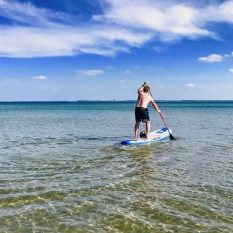
Hi, I’m Manfred. For years I’ve written here on standup-experte.com about SUP and everything that goes with it.

